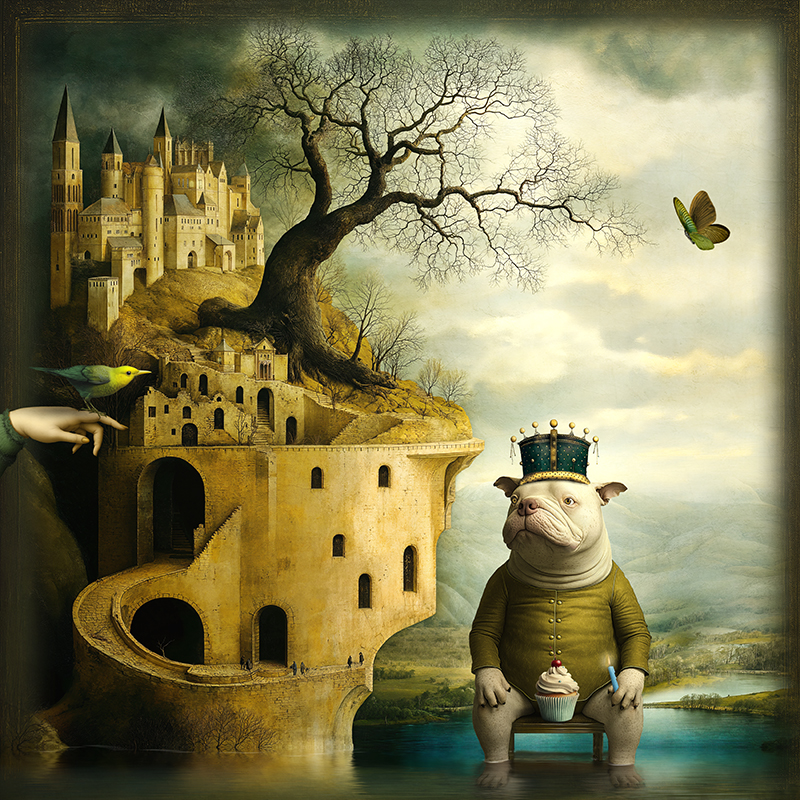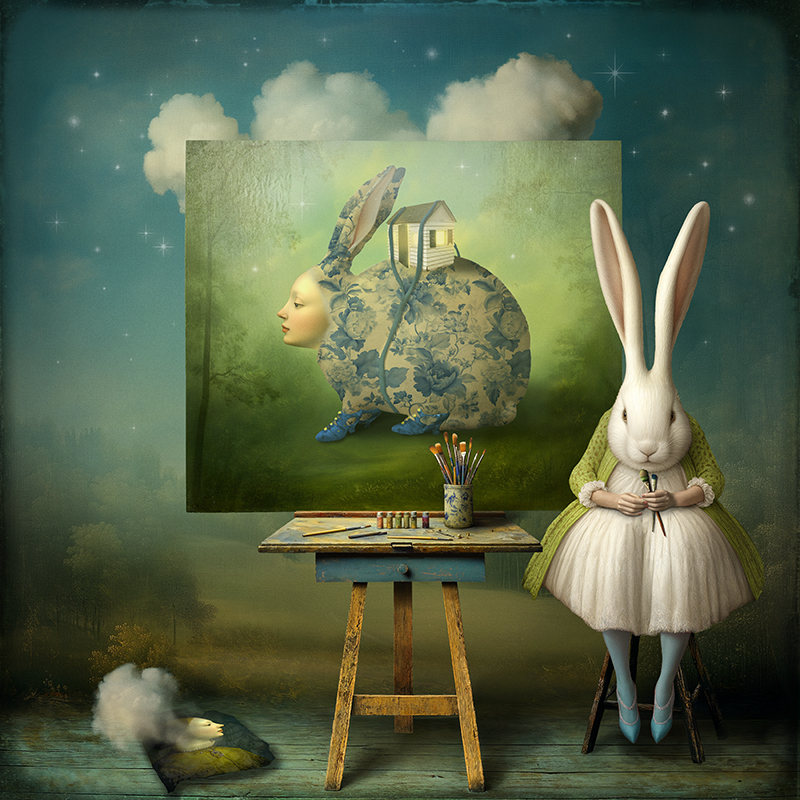Home » Blog
Maggie Taylor: New Work and Commentary on the Creative Process and GenAI
Posted on Jan 30, 2025
As promised, we're back with two new images from Maggie Taylor, including one created this year! Please enjoy The Surrealist and Philosopher’s Pets, as well as some of Maggie's commentary regarding the creative process in the time of GenAI, adapted by Catherine Couturier Gallery from Rebecca Graham's latest article in Silicon Republic. Please visit the gallery to view our selection of prints from Maggie Taylor in person!
Both pieces are available in the following sizes as archival inkjet prints:
8 x 8 inches, edition of 15: $1,700
15 x 15 inches, edition of 15: $3,200
22 x 22 inches, edition of 10: $5,000
36 x 36 inches, edition of 9: $9,000
Maggie Taylor is open about using AI as part of her creative process, even teaching courses on using AI to create art. Her background is in photography, and she has been using a computer to help her create art for about 30 years. In the mid-90s, she heard about people using Adobe Photoshop to alter images. “I think it was either 1994 or 1995, I had access to a good computer for the first time and I got intrigued by the idea of not having to go back into the darkroom and fix things and reshoot things,” she tells Rebecca. “I just thought, this is for me, I’ll never go back into the darkroom again.”
One of her students introduced Taylor to GenAI a couple of years ago. After playing around with different models, she found one that she liked, Midjourney. Taylor creates artworks by layering often hundreds of images on top of each other. These layers include her own photographs, old images (mainly from the 19th century), scans of physical objects and, now, AI-generated images.
“Some of them have hundreds of layers in them and I like the control that I have of being able to place each item where I want in the composition to change things as I’m working. It’s like a dialogue with the image while you’re working. So, the idea of using something from AI as one of my layers seemed like a natural fit.” She has to generate lots of images and make tweaks before she gets what she wants from the AI tool. “I don’t find that it’s possible for me to make a really satisfactory image just straight up from the bot, more like I have to mix it to get what I want.”
Graham asks Taylor if she’s concerned that by feeding the AI model her compositions to train it for herself, she is also training it for anyone who may want to copy her style. Here, she comes back to the idea of “craftsmanship” as she calls it.
“If you’re just relying solely on the bot to make something, and I know some successful artists that do work that way, they generate an AI image and that is the final piece, that’s not me. For me, the dialogue with the image is still the really important part. And that’s why it takes me so long to make them and make decisions. The last book that I did was called Internal Logic. Because it’s like you have to work on an image for such a long time until you get a sense of the internal logic that the image has. And then something clicks, and you realise, OK, now I’m happy with this. That extra craftsmanship is what I think separates it from just cranking out an AI image.”
To read Rebecca Graham's full article please visit the Silicon Republic website.
Maggie Taylor: New Work and Commentary on the Creative Process and GenAI
Posted on Jan 30, 2025
As promised, we're back with two new images from Maggie Taylor, including one created this year! Please enjoy The Surrealist and Philosopher’s Pets, as well as some of Maggie's commentary regarding the creative process in the time of GenAI, adapted by Catherine Couturier Gallery from Rebecca Graham's latest article in Silicon Republic. Please visit the gallery to view our selection of prints from Maggie Taylor in person!
Both pieces are available in the following sizes as archival inkjet prints:
8 x 8 inches, edition of 15: $1,700
15 x 15 inches, edition of 15: $3,200
22 x 22 inches, edition of 10: $5,000
36 x 36 inches, edition of 9: $9,000
Maggie Taylor is open about using AI as part of her creative process, even teaching courses on using AI to create art. Her background is in photography, and she has been using a computer to help her create art for about 30 years. In the mid-90s, she heard about people using Adobe Photoshop to alter images. “I think it was either 1994 or 1995, I had access to a good computer for the first time and I got intrigued by the idea of not having to go back into the darkroom and fix things and reshoot things,” she tells Rebecca. “I just thought, this is for me, I’ll never go back into the darkroom again.”
One of her students introduced Taylor to GenAI a couple of years ago. After playing around with different models, she found one that she liked, Midjourney. Taylor creates artworks by layering often hundreds of images on top of each other. These layers include her own photographs, old images (mainly from the 19th century), scans of physical objects and, now, AI-generated images.
“Some of them have hundreds of layers in them and I like the control that I have of being able to place each item where I want in the composition to change things as I’m working. It’s like a dialogue with the image while you’re working. So, the idea of using something from AI as one of my layers seemed like a natural fit.” She has to generate lots of images and make tweaks before she gets what she wants from the AI tool. “I don’t find that it’s possible for me to make a really satisfactory image just straight up from the bot, more like I have to mix it to get what I want.”
Graham asks Taylor if she’s concerned that by feeding the AI model her compositions to train it for herself, she is also training it for anyone who may want to copy her style. Here, she comes back to the idea of “craftsmanship” as she calls it.
“If you’re just relying solely on the bot to make something, and I know some successful artists that do work that way, they generate an AI image and that is the final piece, that’s not me. For me, the dialogue with the image is still the really important part. And that’s why it takes me so long to make them and make decisions. The last book that I did was called Internal Logic. Because it’s like you have to work on an image for such a long time until you get a sense of the internal logic that the image has. And then something clicks, and you realise, OK, now I’m happy with this. That extra craftsmanship is what I think separates it from just cranking out an AI image.”
To read Rebecca Graham's full article please visit the Silicon Republic website.




Comments (0)
Add a Comment